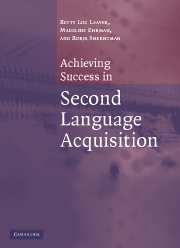Book contents
- Frontmatter
- Contents
- Notes on authors
- Acknowledgments
- Note to the reader
- Part I Learning
- Part II Language
- Part III Independence
- 9 Self-regulation and learner autonomy
- 10 Controlling spoken and written communication
- Epilogue: from here to there: attaining near-native proficiency
- Appendix A Answers to “practicing what you have learned”
- Appendix B Learning strategies taxonomies
- References
- Index
9 - Self-regulation and learner autonomy
Published online by Cambridge University Press: 12 November 2009
- Frontmatter
- Contents
- Notes on authors
- Acknowledgments
- Note to the reader
- Part I Learning
- Part II Language
- Part III Independence
- 9 Self-regulation and learner autonomy
- 10 Controlling spoken and written communication
- Epilogue: from here to there: attaining near-native proficiency
- Appendix A Answers to “practicing what you have learned”
- Appendix B Learning strategies taxonomies
- References
- Index
Summary
Preview
Language learning – if one is to reach high levels of language proficiency – is a long-term commitment. After formal language study, many learners find themselves working independently. The topics in this chapter are related to working independently; they are also of benefit in the classroom since knowing about them can help with pacing and setting priorities. The topics in this chapter are about learning autonomy (taking control of one's own learning) and learner self-regulation (managing priorities, time, and feeling) and include:
Myths about self-direction.
Cognition in self-regulation.
Affect in self-regulation.
Interpersonal dimensions of learner autonomy.
Teacher's role in self-regulated learning
It is an ideal and frequent goal in language teaching that learners will be able to manage their own learning when they leave the classroom and get into the real world of native speakers, newspapers, and films. There is much validity to this goal. The more you can manage your own learning while benefiting from formal instruction, the more likely it is that you will have tools for learning in unstructured settings too. Autonomous learning is influenced by all of the cognitive and affective factors we described in chapters 3, 4 and 5; here we pull together a number of those themes to describe how you can take more control of your own learning.
We have grouped self-regulation and autonomy together in this chapter because learner autonomy depends on effective self-regulation.
- Type
- Chapter
- Information
- Achieving Success in Second Language Acquisition , pp. 201 - 214Publisher: Cambridge University PressPrint publication year: 2005



